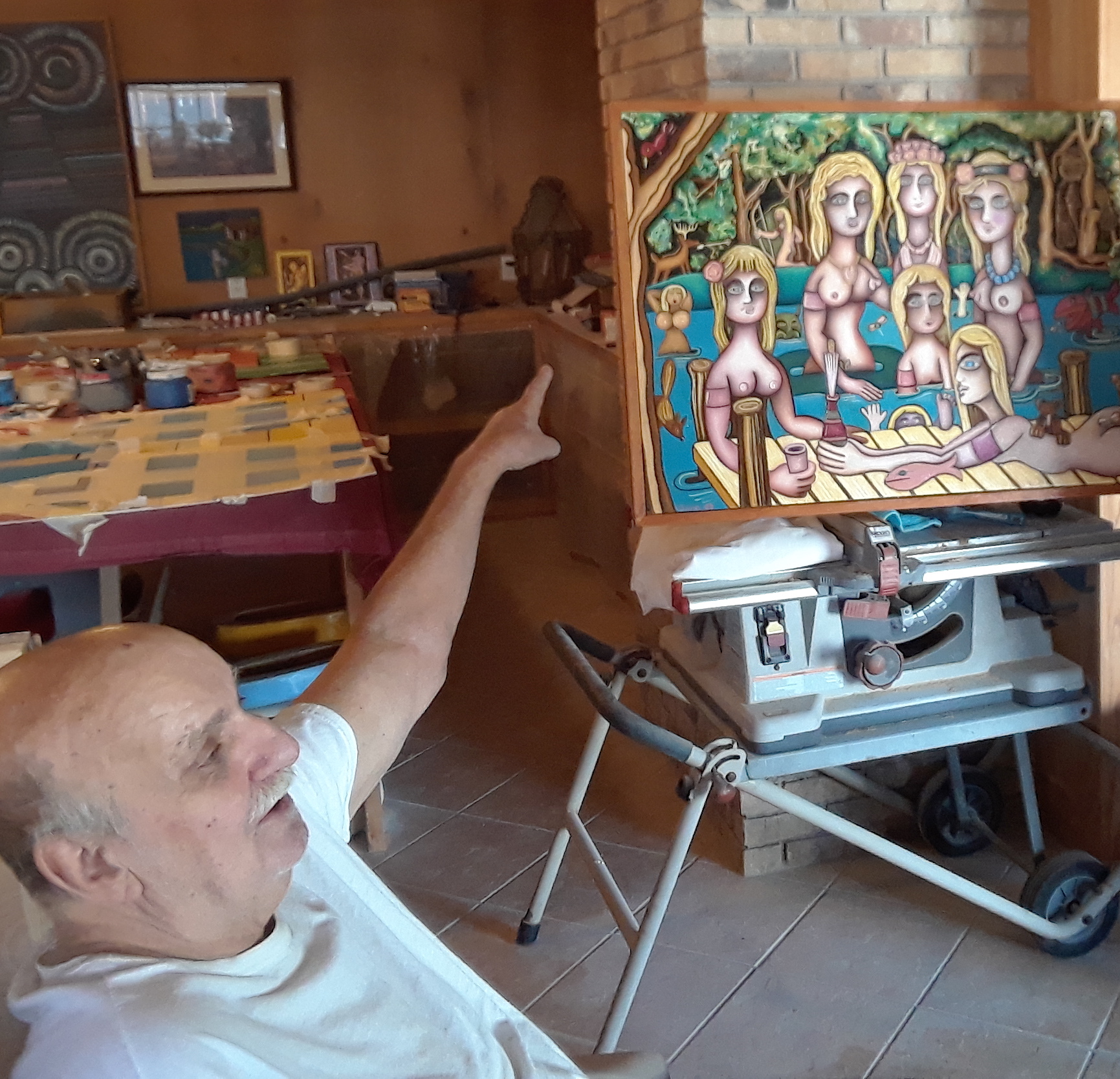
Jim Sohr (Photo by: Morgan Molthrop)
Who: Jim Sohr
What: Painter and sculptor
Where: Chalmette, La.
Morgan Molthrop, author of Tina Freeman’s award-winning photography book, Artist Spaces (UL Press 2014), interviewed Jim Sohr over a cup of duck gumbo during Prospect.4 at Crevasse 22 River House in St. Bernard.
Sohr was born in 1940 in a small town in Wisconsin. He moved to the French Quarter in the 1960’s and then to California before being extradited for the sale of marijuana in Louisiana. He was sent to Angola Penitentiary. Sohr began painting in the prison’s art room and, except for a decade-long stint as an air conditioning repairman in Lafayette, has been painting ever since.
What attracted you to New Orleans?
Getting away from Wisconsin. I was raised in a strict, religious Methodist household and nothing I did pleased my parents. My father wanted me to be a math teacher, and my art was a sense of embarrassment for him. He was a school principal and you would have thought that having a son as an artist was the worst thing that could ever happen to him.
When did you decide to be an artist?
In prison. It took years to get it out of my head: To get to the bottom, I had to go to the bottom. I went to Angola for selling a partially-filled matchbox of marijuana. In some ways jail was better than my upbringing in Wisconsin! To this day I keep two things out of my house: religion and cockroaches.
In Angola I started painting morning, noon, and night seven days a week. I had my coffee pot; I was happy as hell.
What artist most influenced you?
Picasso. When I saw the paintings of six fingered women, I understood that you could break the boundaries. I think that’s the essence of what I am doing, is breaking things apart and putting them back together.
Also, the first time I saw Chagall I understood him. I felt like, here’s this other world. If I can get there, I can get out of this place.
What motivated you to keep going?
Once I started being able to escape into my own head, I felt I could get to a place where no one else could touch me. No one ever told me what to do. I went to a school for art for a brief period and they tried to make me legitimate in their eyes. I just wasn’t having it. If the consequence of that is that you suffer others not receiving your art like you want them to, so be it.
Can you describe your schedule?
My energy level has changed as I have gotten older. I go to sleep about 4:00 p.m. and wake up at midnight. Then paint. I also paint about three hours in the middle of the day. I work in secret because I don’t want people’s reactions to influence my work.
Reaction to your work?
People have strong reactions to my work. Love it or hate it, no one ever walks away saying, “That guy can’t paint.” It’s more about how they feel. I think art should make you feel something.
How does your space influence your art?
I need a huge space, as I am a sculptor as well. Most of my pieces are rather large and there’s a lot of work. I didn’t bother putting interior doors back on the house after Katrina because I live alone and when you are moving art around, it’s just easier to keep as much open as you can.
How does living in Southern Louisiana impact you?
I love St. Bernard Parish and I don’t go to New Orleans if I don’t have to. There’s a community here now that is very tight-knit and supportive. People here are very honest and accepting. I am one of them. But as for oak trees dripping with moss and pirogue boats, you won’t find them in my art.
This interview is available for reprint and re-distribution from Barataria Communications.
 Earthtalk: “Cool Roofs” for New Orleans
It’s hot outside, but it could be cooler! In this article, Brooke Theis explores Cool Roofs, an effective solution to the urban heat island effect that makes the New Orleans heat so unbearable. The author also explores inequalities in how people experience the environment from identity perspectives like race and class.
Earthtalk: “Cool Roofs” for New Orleans
It’s hot outside, but it could be cooler! In this article, Brooke Theis explores Cool Roofs, an effective solution to the urban heat island effect that makes the New Orleans heat so unbearable. The author also explores inequalities in how people experience the environment from identity perspectives like race and class.
 Big Chem-EZ: How can small Louisiana communities access clean drinking water after a hurricane?
When I went to visit the Pointe-au-Chien tribe after Hurricane Ida with my Service Learning class, I heard that one of the biggest challenges in the aftermath of the hurricane was finding enough drinking water, so in this article, I explore water purification methods: 1) when they are necessary, 2) how they work, and 3) if they really make your water safe to drink.
Big Chem-EZ: How can small Louisiana communities access clean drinking water after a hurricane?
When I went to visit the Pointe-au-Chien tribe after Hurricane Ida with my Service Learning class, I heard that one of the biggest challenges in the aftermath of the hurricane was finding enough drinking water, so in this article, I explore water purification methods: 1) when they are necessary, 2) how they work, and 3) if they really make your water safe to drink.
